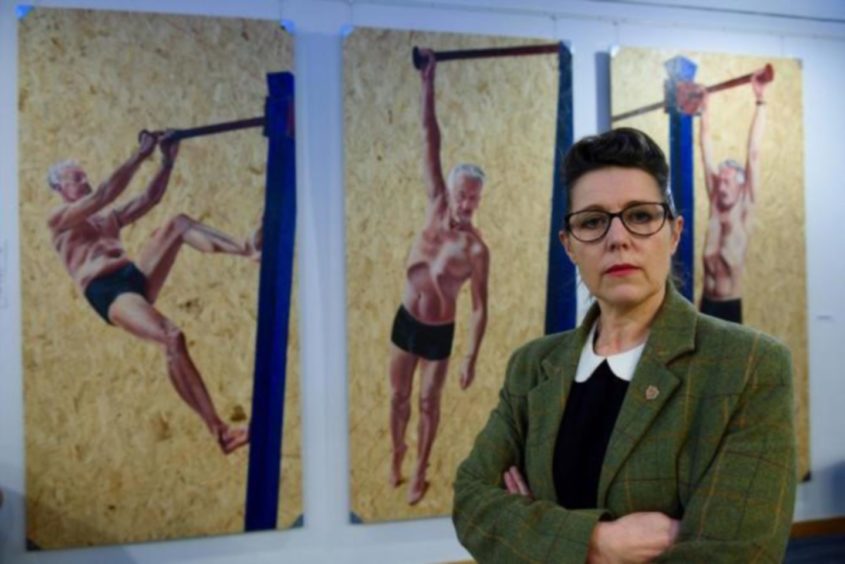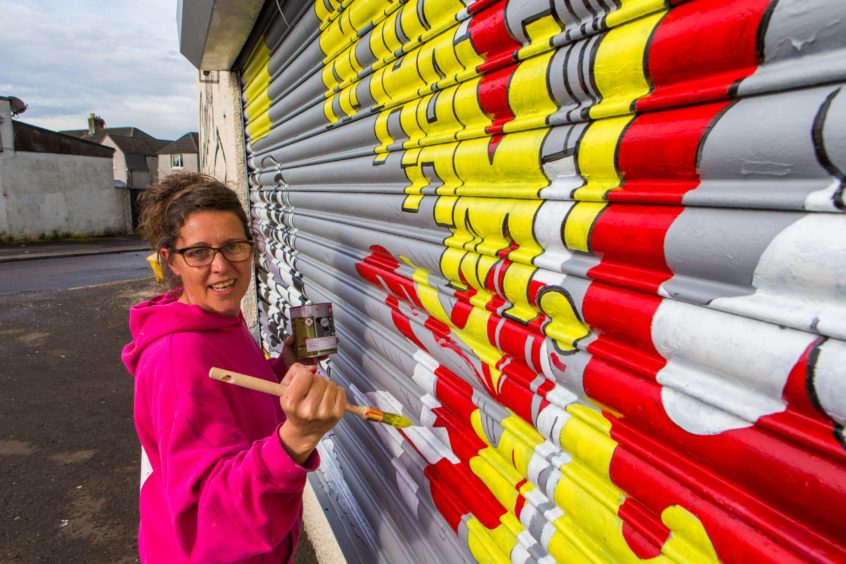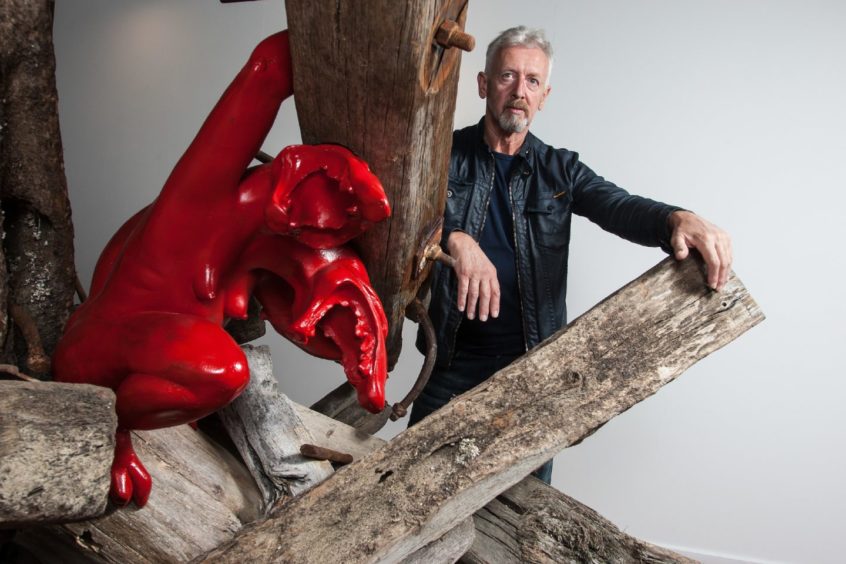Michael Alexander speaks to internationally acclaimed Fife sculptor David Mach about why he wants to throw the match to a semi-naked ‘effigy’ of himself by artists Celie Byrne, Phill Jupitus and Mark Small.
It’s almost 40 years since internationally-renowned Fife born and bred artist David Mach created his first sculpture made from unstruck coloured matchsticks.
It was never his intention for the artwork to go up in flames.
But when the collector who bought Kinskihead in 1982 accidentally set it on fire whilst cleaning it, they agreed the ‘match-heads’ should be viewed as performance pieces and David began setting fire to his match-head work more often.
They included the burning of the devil’s match-head to mark the start of the Edinburgh Art Festival in 2011 and the burning of Jesus Christ’s match-head as the “final creative act” of his award-winning Precious Light exhibition, coinciding with the 400th anniversary of the publication of the King James Bible that same year.
Rather than being an act of destruction, David saw it as a “ferocious act of creation” where colour was replaced by different shades of ash, greys and blacks.
At some point soon, however, David will find himself at the centre of new creative and metamorphic forces when he is given the opportunity to strike a match that sends up in flames a semi-naked ‘effigy’ of himself on his local beach.
The Big Mach Burning Man
The Big Mach Burning Man installation is the brainchild of Kelty-based artist Celie Byrne, stand-up-comedian turned artist Phill Jupitus, who now lives in Pittenweem, and Cupar-based artist Mark Small.
Symbolising transformation and change, and “closing the circle” of David’s recent return from London to Fife, David has been building a bonfire out of driftwood on the beach he’s known since he was a boy with the idea being that the whole sacrificial burning will be filmed.
Mark will score the music for it and Celie visualises the finished piece being projected onto a wall somewhere.
Celie, Phill and Mark all have plans to collect and “re-purpose” the ashes to make new art.
In an interview with The Courier, David laughs when he thinks about how “very Fife” the concept sounds.
“It’s like Brokeback Mountain burning an effigy!” he says.
“I don’t think Celie means it like that at all.
“But it did strike me that if someone else was reading it they might think that.
“I like Fife for that to be honest. That ‘don’t give a f*ck’ attitude!”
A bit daft?
Describing the proposed finale as “very Voodoo, very Wicker Man”, David, who’s known Celie’s famous artist father John Byrne for years, met Celie for the first time when he was giving a lecture at the Edinburgh Festival in 2016.
In 2017 she got in touch “out of the blue” when he was in the studio in London, asking permission to paint him at work in his underpants.
“It all sounded a bit daft!” he smiles.
“I thought ‘oh god!’ It’s funny as it’s the sort of thing you cannae really say no to in a funny kind of way!
“She came to London and took photographs in the studio of me running around in my underwear.
“I offered to do it naked!”
A former pupil of Buckhaven High School and a graduate of Duncan of Jordanstone College of Art and Design in Dundee, David, now 64, went to study at London’s Royal College of Art.
It was in the big smoke that he first got into performance art.
“In those days, you were always being asked to take your kit off at those things which was actually my main reason for being interested in performance because you got to see the occasional naked woman to be quite honest!” he laughs.
However, to be asked to be painted while working in his underpants was “pretty much the first” for him.
When Celie visited, David had no idea she was planning to burn her work.
But more recently she sent him pictures of what the other artists Mark and Phill had done.
It was then he started telling her he’d been collecting driftwood for a fire on the beach and the two things “got mixed up”.
“She must have had it in the back of her mind to do some sort of burning – to do something dramatic with what they’ve got,” he says.
“It’s got something to do with that sort of drama, and because we’re all kind of besotted with the coast of Fife.”
David Mach – hanging around in his pants
Taking up the story, Celie explains that after David agreed for his portrait to be painted, she created a triptych of the former Turner Prize nominated sculptor ‘hanging around’ in his pants. It’s reimagined versions of this work that David will commit to the flames.
“The triptych was painted in oil on 8’ x 4’ sterling boards which took me about a week – a very long week – for a group exhibition at Lochgelly Arts,” she explains.
“The three panels hung in the foyer of the centre before moving to the foyer of the Corn Exchange in Cupar where I was a guest artist for Cupar Arts 2019.
“Mark and Phill were also exhibiting at the same venue – Mark and Carl Smyth with their ‘Skelf’ installation and Phill with his series of collages.
“I knew the triptych had to take on another life so to speak, had to be reimagined somehow.
“So after last year’s lockdown I asked Mark and Phill if they’d be interested in transforming a panel each.
“Mark had been working with fluorescent paint during the lockdown for his ‘Hesitate’ garden installation and Phill was getting ready to resume his studies at Duncan of Jordanstone College of Art and Design.
“I’d recently watched a documentary on Julian Schnabel. He was painting words on huge panels which gave me the idea for how I would adorn my panel.
“So with that information, Phill has written the story of how he met David on the figure surrounded with collage, Mark has blocked in the background in fluorescent paint with a couple of tattoos – painted by my good self – and my own panel has the words ‘I Am Not An Effigy’ which glows green when exposed to sunlight and heat.”
An homage and a fitting tribute
Celie describes the installation as “an homage, a fitting tribute to David Mach: international artist fae Fife, his humour and sense of drama”.
She also thinks it might be a “nice change” for him to set fire to artwork that’s not his own!
While Covid has so far stymied the timing of the burning, the restrictions haven’t stopped them from creating art. In fact, Celie says it’s probably spurred them on.
“Having restrictions has been really motivating because we’re used to working on our own at any given time and on any given scale,” she says.
The proposed venue for the burning, on the beach between Lower Largo and Lundin Links, is significant in that David recently moved back home to Fife with the beach on his doorstep.
From that return to meeting him for the first time in Edinburgh almost five years ago, striking the match on the sands where he’s been building fires out of driftwood since he was 12 “feels like the closing of the circle” as far as Celie is concerned.
“It’s really the visual impact of the setting sun and dramatic skies reflecting off the sea, Edinburgh in the background with the focal point of those flames I’m hoping to capture,” she adds.
“Actually when I think about it, the overall statement is about transformation and change. Quite significant for the sign of our times right now.”
David Mach – a high profile career
David has certainly helped put Fife on the map.
Having exhibited everywhere from New York to Melbourne and famous for provocative public commissions including the tumbling telephone boxes, “Out of Order” in Kingston, “Train” in Darlington and the “Big Heids”, visible from the M8 between Glasgow and Edinburgh, Methil-born David – the son of a Polish father and Scottish mother – was nominated for the Turner Prize in 1988, was elected a member of the Royal Academy of Arts in 1998 and was appointed Professor of Sculpture in 2000.
As he “picks through the bones” of cancellations and postponements in 2020, he’s excited about his first architectural design project planned for Edinburgh this year and is also involved in a new university project in Syria.
But for him The Big Mach Burning Man installation is also an opportunity to reflect on the “huge bank” of creative talent in Fife ranging from artists and writers to playwrights, actors and musicians.
The very fact that someone of the “incredibly high quality” as Phill Jupitus – who he once invited to a Royal Academy dinner – now lives in the East Neuk, adding to an already high calibre eclectic artistic community rooted in Fife, is something that David is “quite fascinated” by.
He wonders if “all that can be turned into some major thing in the not too very distant future.” Who knows, maybe it will even inspire a “Burning Man Festival” type event?
“I hope this is the start of something big here,” he says.
“We had the Largo Arts Festival a couple of years ago now – we couldn’t do it last year because of the Covid thing.
“That went very very well. For a small village to put something on, but to be as interesting artistically to that standard, was great.
“I think we can do something really big in Fife. F*ck you Covid or anything else stopping us!
“I don’t like being held back by any damn thing – especially in the creative fields.”
Influence of Fife
For all his global success, David, who still has a studio in London, is in no doubt that Fife continues having a “huge” influence on his life.
For years people would say to him, ‘are you coming back to Fife?’
There were undoubtedly difficult times when his late wife Lesley – who he met at school – died in 2014 after a brave fight against a long illness.
But despite his travels, David feels like he’s been “lugging Fife around for the last 50 odd years as an artist”.
“Wherever I went,” he says, “because it’s obviously firmly rooted inside me the kind of nature of a Fifer – the nature of this place physically, geographically, the nature in terms of light.
“The nature of it in terms of the kind of belligerence that works in Fife is a really interesting thing for me, you know?
“There’s hardly any place else where you can say one word and get about 30 or 40 different reactions to the thing.
“And it could just be ‘morning’ or ‘hiya’ and you get ‘who the f*ck are you talking to?’ as a response!
“All that sort of stuff. That taught me a hell of a lot. When I was going into competitions and stuff or you’d be invited to be one of the five artists who might do a sculpture on the roundabout outside Swindon, and you had to walk into a room and go and talk to people and explain your work and provide drawings and collage, that got me ready for things like that.
“You could walk into the room with 15 people and know that 14 of them don’t want to f*cking do this. Instantly, you know the one person that did.
“I think that’ a really important thing to learn.
“You also know when people are blowing smoke up your a*se. Bullsh*tting you or are genuinely enthusiastic and interested in what you are doing. I love Fife for all that.
“But I love the idea – the writers and musicians that come out of this bit of the kingdom – it’s really kind of an incredible list.”
























